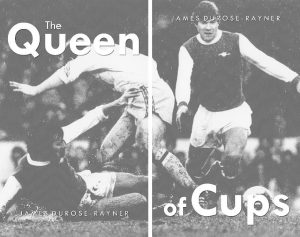Book Review: The Queen of Cups: Part 2, by James Durose-Rayner

So that’s it. The final whistle. The trilogy that has brought readers, I Am Sam, itv seven and The Queen of Cups has concluded.
Throughout all the journey, author James Durose-Rayner has maintained a winning formula which has seen the fictional world of central character Lee Janes mix with the factual football world, focusing on Arsenal FC across the decades. In the first book, I Am Sam, Janes existed in a high-paced chaotic setting which was a whirlwind of dodgy deals and a revolving door of women. By the final part of the trilogy, Queen of Cups: Part 2, the central character has lost none of his roguish charm, but now occupies a more settled space both in his personal and business life, which is reflected in the tempo of the writing of both parts of the Queen of Cups.
This change in Janes can be put down to one person, whose influence grew as the trilogy continued – that being his wife Emily, known as ‘M’. Her influence though is not simply on her once-errant husband, but on all those that she meets. Therefore, it is no coincidence that the title of the final parts of the trilogy could be viewed as a reference and indeed a tribute to ‘M’, as a typical set of tarot cards gives the definition of the Queen of Cups as the following: she is nurturing, caring, compassionate and sensitive. She is a good wife and a loving mother as she is emotionally secure and can connect on an emotional level with others. No intuition is more powerful than that of the Queen of Cups – all traits displayed by the latest Mrs. Janes.
On the flip side however, if the reader was looking for an oblique football reference within the final part’s title, then it may be found in the featuring of the management years of Terry Neil at Highbury. The term ‘Cup Kings’ is one familiar to football fans down the years, so has Durose-Rayner inverted this to the Queen of Cups, pointing the finger at the Gunners who from three FA Cup Final and one European Cup Winners Cup Final during the Neil years, achieved victory just once, despite a wealth of talent such as Alan Hudson (who is wonderfully depicted), Malcolm MacDonald, Liam Brady, Graham Rix and Frank Stapleton.
And that has been one of the strengths of the trilogy in that the strands of reality and fiction engage the reader through different storylines. The personal lives and the emotional journeys of the main characters run comfortably alongside the well-researched insights into the events at Arsenal. The characters and the world they inhabit is all very believable, and for all the bloke-ish banter and humour, the reader also gets to see their vulnerability and sensitivity.
Like the central character Lee Janes, there is more to this trilogy than first meets the eye.
Love it!